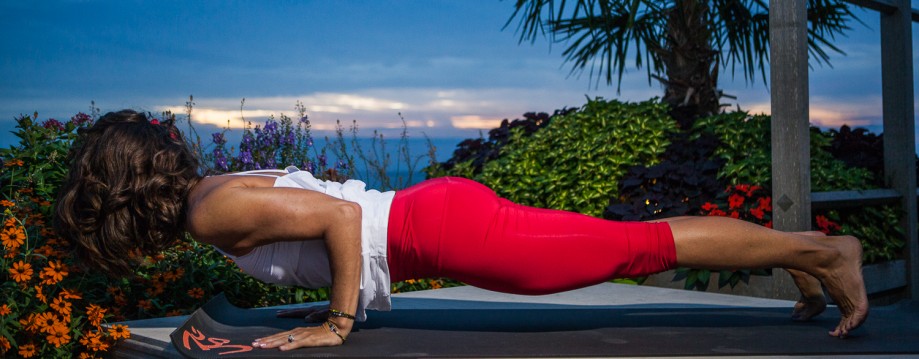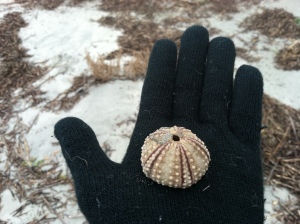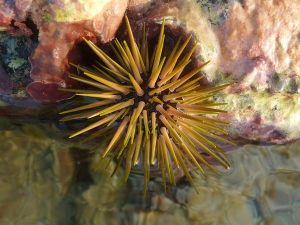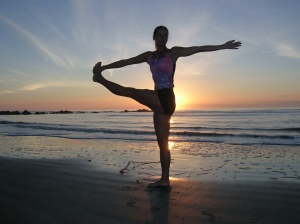I feel giddy with excitement whenever I find the skeleton of a sea urchin that has washed ashore. This is such a big deal to me that I actually have a little sea urchin dance that I do that my husband just shakes his head at. I think the fact that their shell is less than a millimeter thick and is delicate beyond measure leaves me feeling blessed to have found it. It’s quite a miracle that it managed to wash ashore in one piece when you think about the power of the ocean and its constant rhythm. Wave after wave thrusting into the sandy surface with the yanking force it has of pulling all back out to sea that don’t resist. I feel like each and every one I find is a sacred gift from the earth, something to be cherished. I have a bowl filled with their little delicate bodies. When I stare at this bowl I always come back to this one thought “What yoga does for me is a lot like what that urchin has gone through in its life to end up in my hand.”
This tiny little creature when it’s alive moves about the bottom of the ocean seeking just one thing – algae. It’s their version of “samadhi”. Nature has a beautiful way of giving all creatures a fighting chance against their natural predators. Sea Urchins are covered in sharp, pointy spines similar to a hedgehog. They are sometimes called the “hedgehog of the sea”. They move about by these tiny feet that suck water in and out creating their locomotion. They don’t like to be ruffled too much by the ocean, so they tend to like tidal pools. Their life goes on until they are caught by a predator or captured for food, as they are consider a delicacy in some circles. But if their life continues and they die of other causes, they will eventually make it to shore looking nothing like their original, living, breathing form. Their spines are gone, their body hollowed out, and they are an exquisite beauty of perfectly balanced geometric patterns. The lightest touch could break them, yet somehow they manage on occasion to make it ashore in one piece. Their demise allows them to become beautiful art in the eye of the beholder. All are not so lucky, some wash ashore and bust into pieces, looking like tiny remnants of a broken christmas ornament. This skeleton was their home, it was their castle, it was their place of knowingness.
I feel like I’m starting to look like the living breathing form of sea urchin with spines sticking out of me warning all to stay back. Then I head to a yoga class. After I practice I end up feeling like the washed ashore skeleton, what once was prickly, with spines clearly telling all to stay back is now transformed. Yoga has a way of removing the spines I feel like I am arming myself with. It has a way of gutting me of my insides and leaving me open, spacious, and beautifully balanced.
Life has a way of making us feel like we need armor, like how the sea urchin has its coat of sharp spikes protecting it. We tend on occasions to mumble and grumble through life shooing away opportunities for friendship, or adventures based on our perceived threat that these will disturb our comfort with the status quo. We can either prickle our way through life, or we can give in to being more porous, delicate and light. We are creatures of habit and always will be for the most part. We aren’t going to buy a different brand of toothpaste every time we run out, we don’t tend to go to bed at a different time every night, nor do we change habits like how we brush our teeth, or what our morning rituals are. We like routine, we fall comfortably into patterns. However, not all our patterns are working for us. Some of these patterns can start to look a lot like those prickly spines. Keeping out opportunity for growth.
As the opening invocation of Ashtanga yoga says the “samsara halahala”. Not all our patterns are worth keeping not all our cycles are worth repeating. The sea urchins know that in order to go on making an impression in this world even after they die, the best way to do that is to change. It leaves behind a very unique and different version of itself. We are able to do the same. Shed off your layers, your patterns and expose the most minimalist version of who you are: not so weighed down with pins and needles, but light and balanced. Next time you chant the opening prayer see the sea urchin in your mind as it is in life, and then as it is in death. Let it inspire you to quit being so bristly. Keep yourself open and try to become comfortable feeling hollow. Keep trying to stay whole, instead of shattered. Hold strong to your essential self and discard what isn’t essential. Remove the halahala – the poison, like how the poisonous spines of the sea urchin do not wash ashore with it, they release and let go of its old form, so should you.
Try to be delicate, but invincible. Be light, but solid. Be beautiful, but humble. Let others appreciate your beauty, but don’t be attached to your form. Be focused on the one thing that drives you, but don’t be threatened by those that might try to take it away. Move with the current, but be just as content to settle in one place. Be willing to release, so that you can change. Be comforted by the fact that your true self is always there, it is the shell. You are unique, different and beautiful. Stop letting life urch you. Quit being so prickly. Trust me, I have seen the beauty of what yoga can do. It can cleanse you of your history and leave you feeling washed ashore, restful and hollow. But being hollow isn’t bad, things that are hollow let the light shine through.



